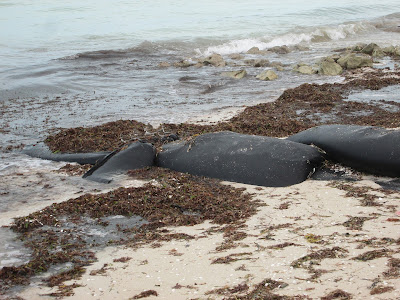Chicxulub Puerto, on the Gulf of Mexico in the western Yucatan, does not yet have the high-rises now blighting most of Florida, but it does have a beach erosion problem, aggravated by the fact that some homes have been built WAY too close to the water, with seawalls and steps where dunes should have been. The seawall of the house we are renting is less than two feet from the high tide line--entirely too close.
Attempts to protect the beaches are being made. The mangroves on the lagoon side of this spit of land are being restored, filtering the water and holding soil. Some homeowners are planting native vegetation to restore or hold the dunes,
and homemade breakwaters of sandbags and tubes are common.
Unfortunately, some of the sandbags used to hold the beach are made up of plastic fibers, eventually shredded by wave action. These fibers wash out to sea and can be ingested by marine creatures, whose digestive systems did not evolve to handle plastic.
Another sand-holding device is washing up on its own--seaweed, and lots of it. While US beachgoers often complain about seaweed and tourism-minded municipalities remove it, clumps of seaweed can act as sand-catchers to help build the dunes that keep beaches from washing completely away. I have read of places that actually rake the seaweed back to the dune line to facilitate the process, although I have yet to see that done here.
What I have seen are seabirds taking advantage of seaweed as a food source. Evidently, large clumps of the stuff are home to all manner of small life forms, which in turn feed other slightly larger life forms like these least sandpipers.
Would you really want to deprive these little guys of their seafood buffet just to have uninterrupted sand?
and homemade breakwaters of sandbags and tubes are common.
Unfortunately, some of the sandbags used to hold the beach are made up of plastic fibers, eventually shredded by wave action. These fibers wash out to sea and can be ingested by marine creatures, whose digestive systems did not evolve to handle plastic.
Another sand-holding device is washing up on its own--seaweed, and lots of it. While US beachgoers often complain about seaweed and tourism-minded municipalities remove it, clumps of seaweed can act as sand-catchers to help build the dunes that keep beaches from washing completely away. I have read of places that actually rake the seaweed back to the dune line to facilitate the process, although I have yet to see that done here.
What I have seen are seabirds taking advantage of seaweed as a food source. Evidently, large clumps of the stuff are home to all manner of small life forms, which in turn feed other slightly larger life forms like these least sandpipers.
Would you really want to deprive these little guys of their seafood buffet just to have uninterrupted sand?




No comments:
Post a Comment